Bonsai styles, their silhouettes and shapes
Over the years, many styles of Bonsai have been developed that serve to classify macrobonsai trees; These styles evoke situations and circumstances very similar to those found in nature. These styles are open to personal interpretation and creativity which means that the trees do not necessarily need to conform to a certain shape.
Note that the explanation of styles is important for a basic understanding of shapes and should serve as guidelines for successfully modeling miniature trees.
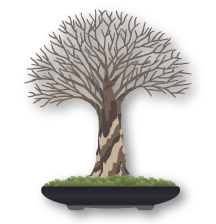
Broom-style bonsai (Hokidachi)
This broom style is suitable for leafy deciduous trees with thin branches. The trunk is straight and does not reach the apex; branching begins 1/3 of the height in all directions. This is how a ball-shaped glass is produced, which is very beautiful during winter.
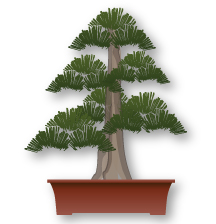
Formal vertical style bonsai (Chokkan)
The formal vertical style is very common in the art of Bonsai. This style is also often found in nature, especially in bright places where the tree does not face competition from other trees. The straight trunk must clearly show a taper; that is, the lower part has to be thicker than the upper part. The first branches grow to a quarter of the height of the trunk. A branch forms the apex; therefore, the trunk is not the highest point of the tree.
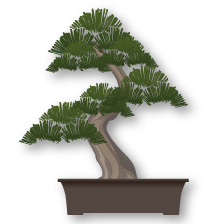
Casual upright style bonsai (Moyogi)
The informal upright style is very common, both in Bonsai and in nature. The trunk snakes upward and from each bend grows a branch. The trunk must visibly show a taper.
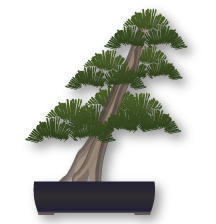
Slant-style bonsai (Shakan)
In nature, a tree can grow inclined due to the prevailing wind in one direction or because it was born in a shady area and grows towards the light. In this slanted style of macrobonsai, the tree has to grow at an angle of 60º- 80º to the ground. The roots on one side are well developed and thus keep the tree standing. On the side the tree leans towards, the roots are clearly less developed. The first branch grows in the opposite direction to the inclination of the tree to maintain balance. The trunk may be straight or slightly sloping, but it must be taper, thick at the base, and it must taper to the apex.
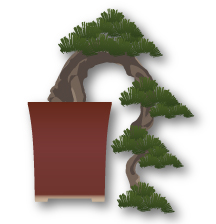
Waterfall Bonsai (Kengai)
A tree that grows in nature on a steep mountain wall can be bent by various causes, such as falling snow or rocks, and then it grows downward. It can be difficult to get downward growth on Bonsai as it takes place against natural direction. This style of Bonsai is planted in tall pots. The trunk ascends a short distance and then bends over itself in the opposite direction. The apex usually grows above the pot, but the alternate branches grow from a trunk that snakes downward. To maintain balance, these branches have to grow horizontally to balance the tree.
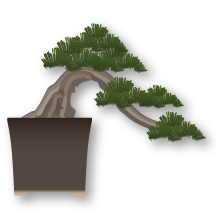
Semi-waterfall style bonsai (Han-kengai)
The semi-waterfall style, like the waterfall style, emulates the natural growth of trees on steep cliff walls, but also on the banks of rivers and lakes. The trunk usually goes up a little and then bends down, but never falls below the pot. The apex grows above the pot, the other branches are lower.
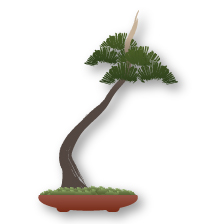
Literati style bonsai (Bunjingi)
The Literati style is the best example of trees that have to fight for their existence. In nature, these types of trees are found in places where competition from other plants is so great that the only way to survive is to grow above all of them. The trunk snakes up and is bare because only the upper part receives enough sunlight. To make the Bonsai Literati appear even more resistant, the bark is removed from some dry branches (what is called Jin) or from a part of the trunk (what is called Shari). These trees are usually planted in small, round pots.
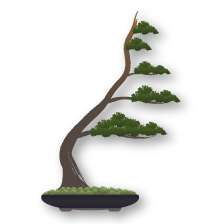
Windswept-style bonsai (Fukinagashi)
The Fukinagashi style is also a good example of trees that have to fight to survive. All the branches and the trunk grow in one direction, as if the wind is constantly blowing and whipping the tree to one side. The branches alternate to the left and to the right of the trunk, but eventually they all lean in one direction.
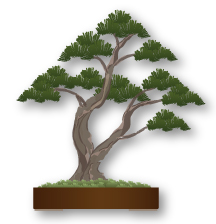
Double Trunk Style Bonsai (Sokan)
The double trunk is a very common shape in nature, but you don’t see much of it in Bonsai. Typically two trunks grow from a single root system, but it is also possible for a smaller trunk to emerge from the main trunk very close to the ground. The trunks differ greatly in thickness and height: the thicker and more developed trunk grows in an almost vertical direction, but the thinner trunk leans out a little. The two trunks form a single tree canopy.
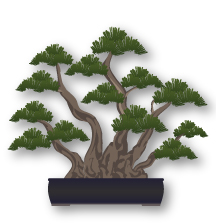
Multi-log Bonsai (Kabudachi)
The Kabudachi style is actually the same as the double log style, but with 3 or more logs. The trunks all grow from a single root system, so it is a single tree. The trunks have a collective crown with a single apex that will be formed by the thickest and most developed trunk.
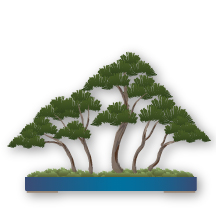
Bonsai forest (Yose-ue)
The Yose-Ue style is very similar to the multi-log style, but with one important difference: the forest consists of loose trees that form a group. The most developed trees are usually found in the middle of the pot, which is usually large and flat. Smaller trees are planted further to the sides so that a single canopy of leaves is formed. You should avoid planting the trees in a straight line, so the forest looks much more natural.
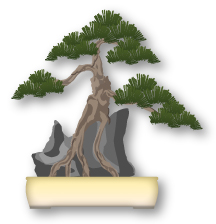
Rock-hugging bonsai (Seki-joju)
In a rocky soil the roots of the trees are forced to look for the fertile soil that is in the hollows and fissures. The roots are bare on the rocks, so they are covered with a trunk-like bark to protect themselves from the sun. As the roots that grow on the stone then sink into the soil of the pot, the care of this type of tree does not differ from that of other styles. In principle, Bonsai can have many shapes, but some styles appear more natural than others. Maple trees are often used for this style.
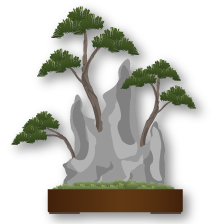
Rock-rooted style bonsai (Ishisuki)
In this style the trees grow inside the holes or fissures of a rock, which means that there is only a very small space where they can develop and absorb nutrients. For this reason, the trees that grow inside a rock should not give the impression of being healthy plants that grow quickly but on the contrary they should give the impression that the tree is struggling to survive. Obviously it is necessary to water and fertilize regularly since the storage capacity of water and nutrients in the earth and within the rock is very small. The rock within which bonsai grows is usually placed in a flat pot containing water or gravel.
Visit our page www.macrobonsai.com.
